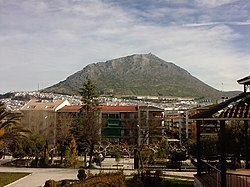Martos
| Martos | |||
|---|---|---|---|
| Municipality | |||

View of the rock of Martos from the Manuel Carrasco park.
|
|||
|
|||
| Nickname(s): La ciudad de la Peña | |||
| Location in Spain | |||
| Coordinates: 37°43′N 3°58′W / 37.717°N 3.967°WCoordinates: 37°43′N 3°58′W / 37.717°N 3.967°W | |||
| Country |
|
||
| Autonomous community |
|
||
| Province |
|
||
| Comarca | Metropolitana | ||
| Judicial district | Martos | ||
| Government | |||
| • Alcaldesa | Custodia Martos Luque (2011) (PA) | ||
| Area | |||
| • Total | 259.10 km2 (100.04 sq mi) | ||
| Elevation | 753 m (2,470 ft) | ||
| Population (2008) | |||
| • Total | 24,520 | ||
| • Density | 95/km2 (250/sq mi) | ||
| Demonym(s) | Marteño/a, tuccitano/a | ||
| Time zone | CET (UTC+1) | ||
| • Summer (DST) | CEST (UTC+2) | ||
| Postal code | 23600 | ||
| Dialing code | (+34) 953 55 XX XX (+34) 953 70 XX XX | ||
| Website | www |
||
Martos is a city in the province of Jaén in the autonomous community of Andalusia in south-central Spain.
It has a population of 24063 inhabitants, making Martos the fifth largest municipality in the province. The city is located on a western peak of the Sierra Jabalcuz mountain range. It belongs to the metropolitan Area of Jaén, of which it is considered to be the second most important city after the capital.
Its economy is based on agriculture, in particular the cultivation of the olive tree. Martos is considered to be the first producer of olive oil of the world. Also important are various industries, especially those related to the treatment of plastic.
The city has been linked to the Roman settlement of Colonia Augusta Gemella, and starting in the 8th century was ruled by the Moors under various Islamic states for over 500 years.
In 1225, King Ferdinand III of Castile and Leon captured the city from the Moors and incorporated it into his kingdom.
During the Middle Ages, Martos became a strategic place, and its defences were reinforced with the construction of numerous fortifications in the city.
At the end of the 19th century and beginning of the 20th, Martos underwent significant economic and urban development (reflected in the city's architecture), in large part due to the wealth derived from the industrial production of olive oil. Martos thus became one of the most prosperous cities of eastern Andalusia.
Around 250 AD, a bishopric was established in present Martos under the name Tucci, on territory from the suppressed Diocese of Iliturgi. It was a suffragan of the Metropolitan Roman Catholic Archdiocese of Sevilla.
...
Wikipedia



